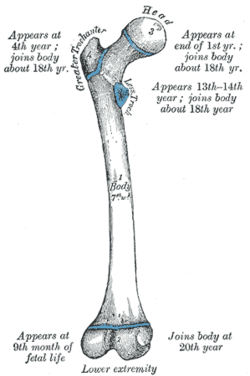Femora
| Femur | |
|---|---|

Position of femur (shown in red)
|
|

Left femur seen from behind.
|
|
| Details | |
| Origins | Gastrocnemius, vastus lateralis, vastus medialis and vastus intermedius |
| Insertions | Gluteus maximus, gluteus medius, gluteus minimus, iliopsoas, lateral rotator group, adductors of the hip |
| Articulations |
hip: acetabulum of pelvis superiorly knee: with the tibia and patella inferiorly |
| Identifiers | |
| Latin | Os femoris, os longissimum |
| MeSH | A02.835.232.500.247 |
| TA | A02.5.04.001 |
| FMA | 9611 |
|
Anatomical terms of bone
[]
|
|
The femur (/ˈfiːmər/, pl. femurs or femora /ˈfɛmərə, ˈfɛmrə/) or thigh bone, is the most proximal (closest to the hip joint) bone of the leg in tetrapod vertebrates capable of walking or jumping, such as most land mammals, birds, many reptiles such as lizards, and amphibians such as frogs. In vertebrates with four legs such as dogs and horses, the femur is found only in the hindlimbs. The head of the femur articulates with the acetabulum in the pelvic bone forming the hip joint, while the distal part of the femur articulates with the tibia and kneecap forming the knee joint. By most measures the femur is the strongest bone in the body. The femur is also the longest bone in the body.
...
Wikipedia
